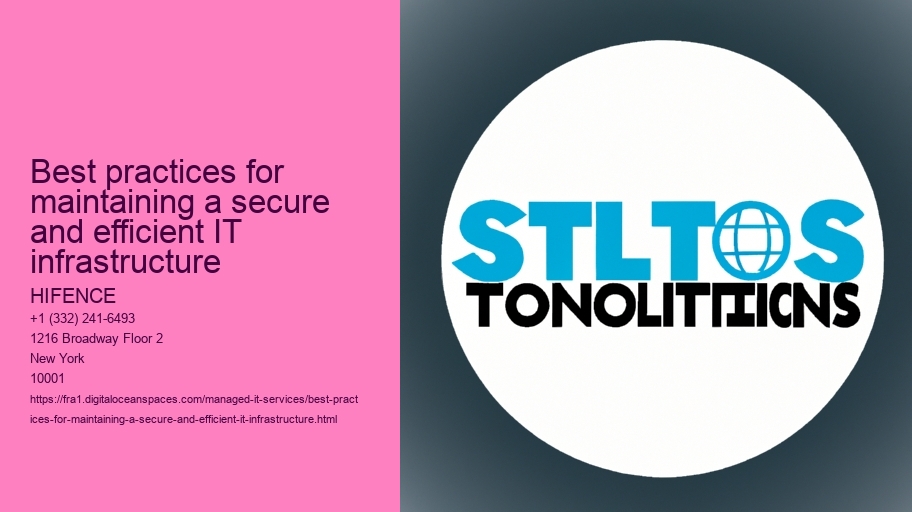
It is crucial to regularly update software and security patches to maintain a secure and efficient IT infrastructure. Ignoring these updates can leave your systems vulnerable to cyber attacks and data breaches. It's important to stay on top of these updates to ensure the protection of your company's sensitive information. Don't forget to schedule regular maintenance checks to keep your systems running smoothly. By staying proactive and updating regularly, you can minimize the risk of potential security threats.
Implementing strong password policies and multi-factor authentication are crucial steps in maintaining a secure and efficient IT infrastructure! By requiring employees to create complex passwords and verifying their identities through multiple factors, you can significantly reduce the risk of unauthorized access to sensitive information.
Without these measures in place, your organization is vulnerable to cyber attacks and data breaches. managed service new york Hackers are constantly looking for ways to exploit weak passwords and steal valuable data. Don't let your company become a victim of these malicious attacks!
Furthermore, enforcing strong password policies and multi-factor authentication can help streamline your IT operations by preventing unauthorized users from gaining access to your systems. This can save your organization time and money in the long run by avoiding costly security breaches and downtime.
In conclusion, it is essential to prioritize the security of your IT infrastructure by implementing strong password policies and multi-factor authentication. managed services new york city Take proactive steps to protect your organization from potential threats and ensure the safety of your data.
Regular security audits and risk assessments are essential for maintaining a secure and efficient IT infrastructure. These processes help identify vulnerabilities and potential threats that could compromise the integrity of your systems. By conducting these assessments on a routine basis, you can stay one step ahead of cyber attackers and ensure that your data is protected. Neglecting to perform these audits puts your organization at risk for data breaches and other security incidents. So, be proactive and make sure to schedule regular audits to keep your IT infrastructure safe and secure!
Backing up data regularly and testing restore procedures are essential practices for maintaining a secure and efficient IT infrastructure. It is crucial to ensure that all important data is backed up on a regular basis to prevent any potential loss in the event of a system failure or cyber attack.
By neglecting to backup data regularly and test restore procedures, organizations are putting themselves at risk of losing valuable information and facing potential downtime. Without proper backups and testing, recovering from a data loss can be a time-consuming and costly process.
Therefore, it is imperative to make backing up data and testing restore procedures a priority in order to safeguard your organization's data and maintain a reliable IT infrastructure. Remember, prevention is always better than cure when it comes to protecting your valuable information!
Monitoring network traffic and implementing intrusion detection systems are key practices for maintaining a secure and efficient IT infrastructure. By keeping a close eye on the data flowing through your network, you can quickly identify any suspicious activity and take action before it becomes a serious threat! Neglecting to monitor your network traffic can leave you vulnerable to cyber attacks and data breaches, putting your organization at risk of significant financial and reputational damage.
Intrusion detection systems are essential tools for detecting and responding to unauthorized access attempts and other security incidents. They can help you identify potential threats in real-time and take proactive measures to protect your network and sensitive data. check Without these systems in place, you may not even be aware that your network has been compromised until it's too late.
By following best practices like monitoring network traffic and implementing intrusion detection systems, you can significantly reduce the likelihood of a security breach and ensure that your IT infrastructure remains secure and efficient. Don't underestimate the importance of these measures – your organization's security depends on it!
When it comes to maintaining a secure and efficient IT infrastructure, one of the key steps is to educate employees on cybersecurity best practices!
It's important to regularly update employees on the latest threats and trends in cybersecurity, as well as provide them with the tools and knowledge they need to protect themselves and the company. This can include everything from strong password practices to recognizing phishing emails and avoiding suspicious links.
By making cybersecurity a priority and investing in ongoing education and training for your employees, you can create a culture of security within your organization. Remember, a strong defense is the best offense when it comes to protecting your IT infrastructure. So, don't wait until it's too late to take action - start educating your employees today!
When it comes to maintaining a secure and efficient IT infrastructure, one of the best practices is to restrict access to sensitive data and systems on a need-to-know basis. This means that only those individuals who require access to certain information or systems in order to perform their job duties should be granted permission to do so. By limiting access in this way, organizations can minimize the risk of unauthorized users gaining entry to sensitive data and potentially compromising the security of the entire system.
By following this practice, companies can ensure that their data remains secure and that only those with a legitimate need for access are able to view or manipulate it. This can help to prevent data breaches and other security incidents that could have serious consequences for the organization.
In addition to restricting access, it is also important for organizations to implement other security measures such as encryption, firewalls, and regular security audits. By taking a proactive approach to security, companies can better protect their data and systems from potential threats.
Overall, restricting access to sensitive data and systems on a need-to-know basis is a critical component of maintaining a secure and efficient IT infrastructure.